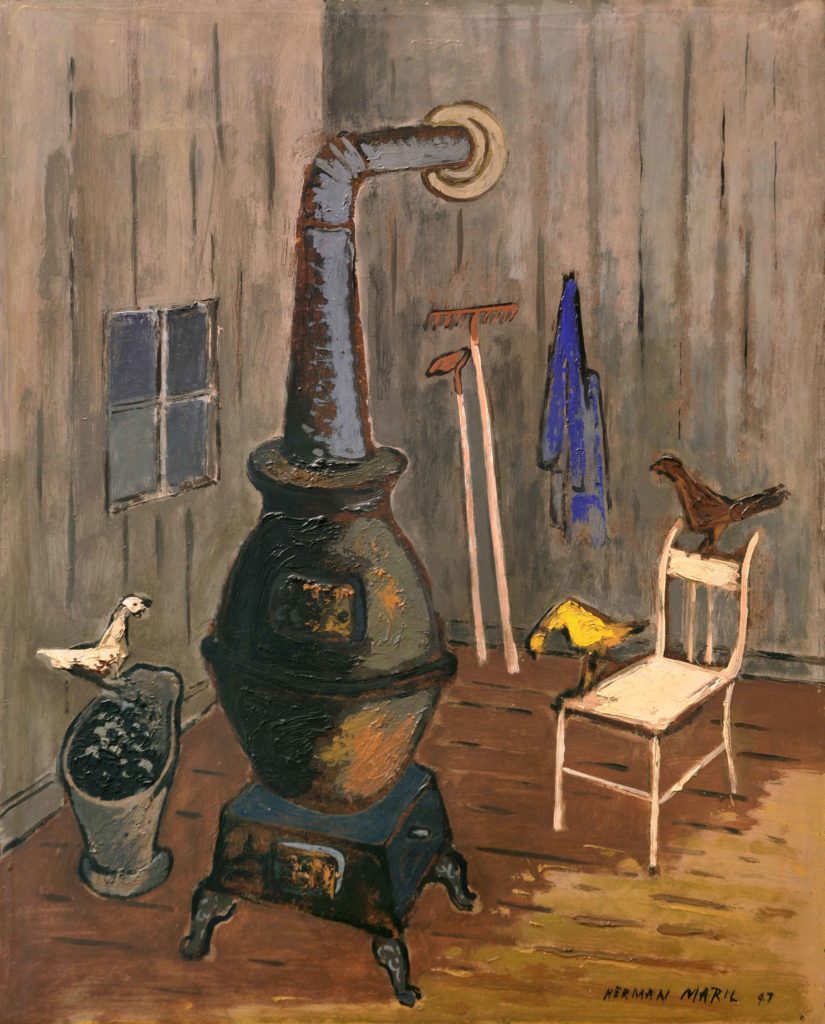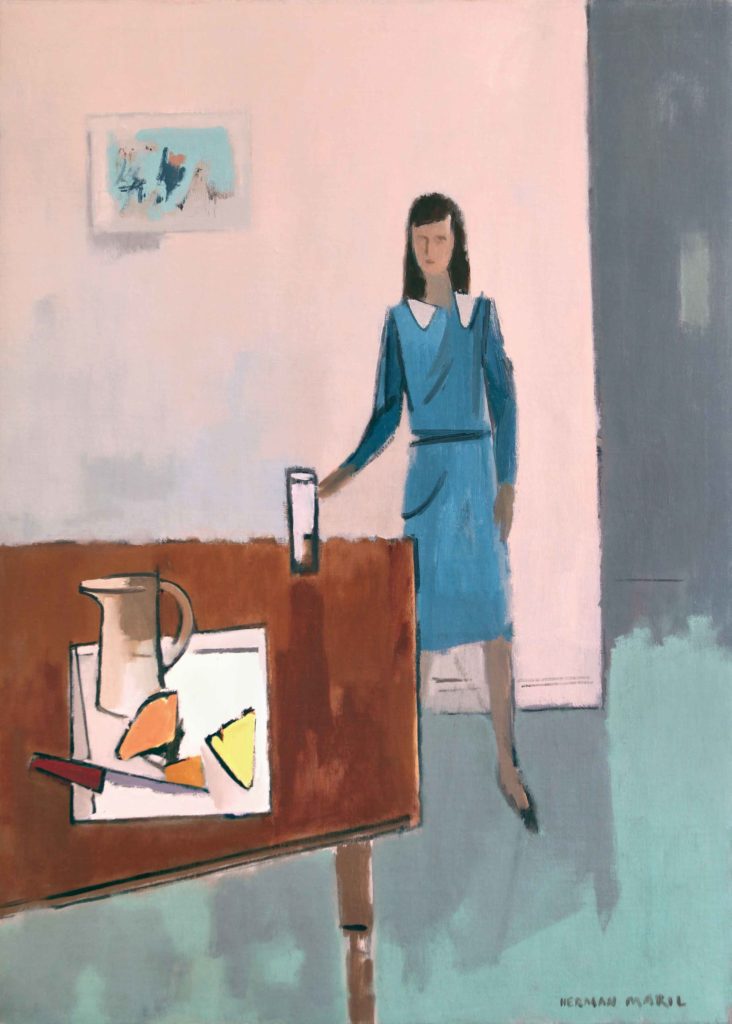Fine Art Oil Paintings on View > Herman Maril (1908–1986), nationally recognized Modernist painter, is noted for his seductive paintings of subdued domestic interiors, sundrenched seaside vistas, and expansive landscapes. Maril was decidedly a contemplative artist who balanced intellect with intuition—creating figurative works that eliminate all but the barest essentials.

An exhibition of Maril’s oil paintings from the 1930s through the 1980s, entitled “A Life in Art,” is on view through October 2, 2021 at LewAllen Galleries in Santa Fe, New Mexico.
From the gallery:
Herman Maril’s oil paintings consistently demonstrate a clarity of structure and color that bears the hallmarks of thoughtful abstraction. His forms and figures are often depicted in a flattened, spare, but highly orchestrated manner, reducing his forms to broad, flat areas of restful and delicate colors loosely applied. The geometries of the compositions are based largely on subtle relationships among washes of color, and this interplay consistently provides the organizing and emotive power in his works.
Born in Baltimore in 1908, Herman Maril graduated from the Maryland Institute—Baltimore’s nationally prestigious art academy—in 1928, at which point he had already become respected in Baltimore as a sophisticated Modernist artist. Early in his career, Maril often outlined his images with dark lines, using vertical and lateral forms to create structure, tension, and energy (his use of outline fell away in his later work). At this time his imagery also demonstrated the strong influence of the Ashcan Art movement, which celebrated scenes of everyday life. Maril infused these works with tight structure and a joyful juxtaposition of shapes and colors.
In 1935, the American Magazine of Art published a review by the noted art critic, Olin Dows, who captured the essence of Maril’s works—an essence that remained true throughout the artist’s lifetime: “Each picture has its core; each is beautifully conceived and organized…. Each is distinct in mood… and clothed in poetry.”

In 1934, Maril and his work were discovered and ardently admired by the legendary Duncan Phillips, founder of the Phillips Collection in Washington, DC, which now owns an extensive collection of Maril’s works as it does of the paintings of Milton Avery, Maril’s close friend. In 1934, First Lady Eleanor Roosevelt chose a painting by Herman Maril of the Baltimore waterfront to hang in the White House. Years later, in 1977, “Maril’s Interior with Cat,” a 1972 oil painting, was selected to hang in the office of U.S. Vice President Walter Mondale (1977-81).
In the 1940s, Abstract Expressionism changed the face of American art with new artistic reorientations that obliquely provided Maril tacit permission to further develop his own artistic vocabulary. Maril’s newly expanded vision of art embraced the vastness of the beaches, tumbling surf, and extensive ocean vistas of Provincetown, where he spent each summer from 1948 onward. Importantly, Maril also developed friendships with other artists in Provincetown, particularly Milton Avery. Maril and Avery frequently visited each other’s studios and discussed each other’s work, developing a kinship that would impact both artist’s careers.

The art that Maril created in the 1940s proved to be a crucial turning point in his paintings. His canvases became larger, and the sense of space opened up to provide a feeling of expansiveness. His colorations, while still of a limited palette, become more emotional, nuanced, and intimate. His compositions became freer and more daring, and the imagery often energetically tilted toward the viewer as if offering the details for the viewer’s closer perusal. The reductive exposition and warm colorations provide an immediate sense of intimacy with the works—an intimacy that lasted through the decades of his career.

Maril’s art is consistently warm and lyrical, but does not easily fit into any specific category of Modernism. His thoughtful, yet intuitive approach culminated in the creation of a body of work that invites his viewers to enter into his painted worlds, through its gently abstracted imagery and nuanced, joyful colorations. As Herman Maril once stated, “I want a stark statement, but a statement that is full of human feeling.”
Maril’s works are in the permanent collections of more than 75 national and international museums, including The Whitney Museum, The Metropolitan Museum, the Walters Art Museum, and the Baltimore Museum of Art. In Washington, DC, Maril’s works can be found in the collections of the Smithsonian American Art Museum, the National Portrait Gallery, and The Phillips Collection. His work is also in the collections of the Bezalel National Art Gallery in Israel. In 1978, Maril was inducted into The American Academy of Arts and Letters.
For more details about Herman Maril and his oil paintings featured in “A Life in Art,” please visit LewAllenGalleries.com.
> Visit EricRhoads.com to learn about more opportunities for artists and art collectors, including retreats, international art trips, art conventions, and more.
> Sign up to receive Fine Art Today, our free weekly e-newsletter
> Subscribe to Fine Art Connoisseur magazine, so you never miss an issue








